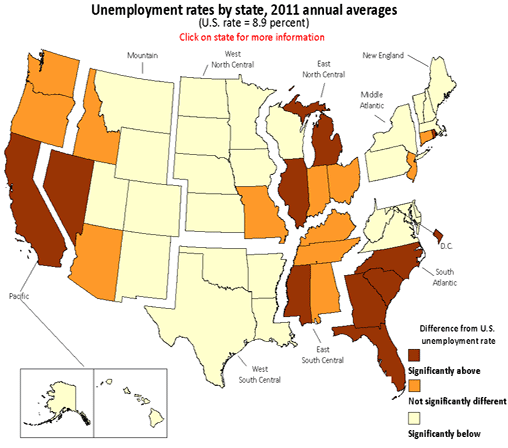An official website of the United States government
 United States Department of Labor
United States Department of Labor
In 2011, 28 states had annual average unemployment rates that were significantly lower than the U.S. rate of 8.9 percent, while 10 states and the District of Columbia recorded rates significantly above it. The remaining 12 states had unemployment rates that were not statistically different from the U.S. rate.

| State | Unemployment rate | Difference from U.S. rate |
|---|---|---|
Alabama | 9.0 | Not significantly different |
Alaska | 7.6 | Significantly below |
Arizona | 9.5 | Not significantly different |
Arkansas | 8.0 | Significantly below |
California | 11.7 | Significantly above |
Colorado | 8.3 | Significantly below |
Connecticut | 8.8 | Not significantly different |
Delaware | 7.3 | Significantly below |
District of Columbia | 10.2 | Significantly above |
Florida | 10.5 | Significantly above |
Georgia | 9.8 | Significantly above |
Hawaii | 6.7 | Significantly below |
Idaho | 8.7 | Not significantly different |
Illinois | 9.8 | Significantly above |
Indiana | 9.0 | Not significantly different |
Iowa | 5.9 | Significantly below |
Kansas | 6.7 | Significantly below |
Kentucky | 9.5 | Not significantly different |
Louisiana | 7.3 | Significantly below |
Maine | 7.5 | Significantly below |
Maryland | 7.0 | Significantly below |
Massachusetts | 7.4 | Significantly below |
Michigan | 10.3 | Significantly above |
Minnesota | 6.4 | Significantly below |
Mississippi | 10.7 | Significantly above |
Missouri | 8.6 | Not significantly different |
Montana | 6.8 | Significantly below |
Nebraska | 4.4 | Significantly below |
Nevada | 13.5 | Significantly above |
New Hampshire | 5.4 | Significantly below |
New Jersey | 9.3 | Not significantly different |
New Mexico | 7.4 | Significantly below |
New York | 8.2 | Significantly below |
North Carolina | 10.5 | Significantly above |
North Dakota | 3.5 | Significantly below |
Ohio | 8.6 | Not significantly different |
Oklahoma | 6.2 | Significantly below |
Oregon | 9.5 | Not significantly different |
Pennsylvania | 7.9 | Significantly below |
Rhode Island | 11.3 | Significantly above |
South Carolina | 10.3 | Significantly above |
South Dakota | 4.7 | Significantly below |
Tennessee | 9.2 | Not significantly different |
Texas | 7.9 | Significantly below |
Utah | 6.7 | Significantly below |
Vermont | 5.6 | Significantly below |
Virginia | 6.2 | Significantly below |
Washington | 9.2 | Not significantly different |
West Virginia | 8.0 | Significantly below |
Wisconsin | 7.5 | Significantly below |
Wyoming | 6.0 | Significantly below |
These data are featured in the TED article, State unemployment rates, 2011.
In 2011, 30 states posted statistically significant unemployment rate decreases, the largest of which was in Michigan (−2.4 percentage points). Four additional states experienced decreases greater than 1.0 percentage point: Ohio (−1.4 points), Utah (−1.3 points), Oregon (−1.2 points), and Indiana (−1.1 points). The remaining 20 states and the District of Columbia reported annual average unemployment rates for 2011 that were not appreciably different from those of the previous year, even though some had changes that were at least as large numerically as the significant changes.
Eight states and the District of Columbia reported unemployment rates of 10.0 percent or more in 2011. Nevada again posted the highest unemployment rate, 13.5 percent, followed by California, 11.7 percent. North Dakota registered the lowest jobless rate among states for the third year in a row, 3.5 percent, followed by Nebraska, 4.4 percent.
These unemployment data are from the Local Area Unemployment Statistics program. For more information, see "Regional and State Unemployment — 2011 Annual Averages" (HTML) (PDF), news release USDL-12-0371.
Bureau of Labor Statistics, U.S. Department of Labor, The Economics Daily, State unemployment rates, 2011 at https://www.bls.gov/opub/ted/2012/ted_20120313.htm (visited January 01, 2026).

